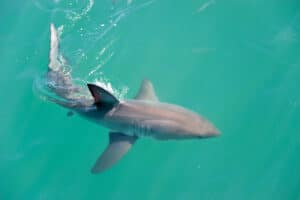Have you ever wondered just how many sharks bigger than great white sharks are swimming in our oceans today? What about long-extinct sharks, like Megalodon?
If so, then you’ve come to the right place. You’ll not only learn about the largest living sharks in the world, but you’ll also learn about some of the largest sharks that existed millions of years ago. Here’s a preview of the 10 sharks we will discuss:
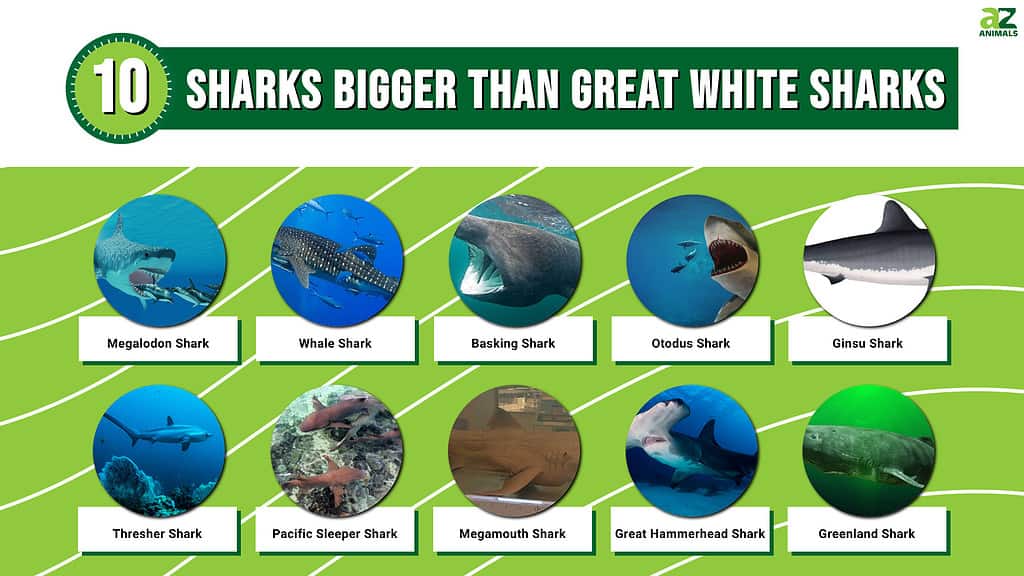
All sharks are actually long-bodied fish. Most of them are carnivorous predators and are covered in small teeth-like scales known as dermal denticles. These coverings allow ocean hunters to move through the water more easily.
Sharks are also known for their cartilage skeletons, which have a flexible but sturdy structure. Different shark species, with these common features, appear in all five of the world’s oceans and in many different variations and sizes.
While the largest great white on record – nicknamed Deep Blue – weighs about 5,000 pounds and measures 20 feet in length, most great whites are significantly smaller. Fully grown females average about 15 feet in length while males are shorter and reach an average length of about 12 feet.
So, it might surprise you to learn that many sharks can reach a larger size than the average great white shark! Read on to learn about ten sharks bigger than great white sharks!
10. Greenland Shark
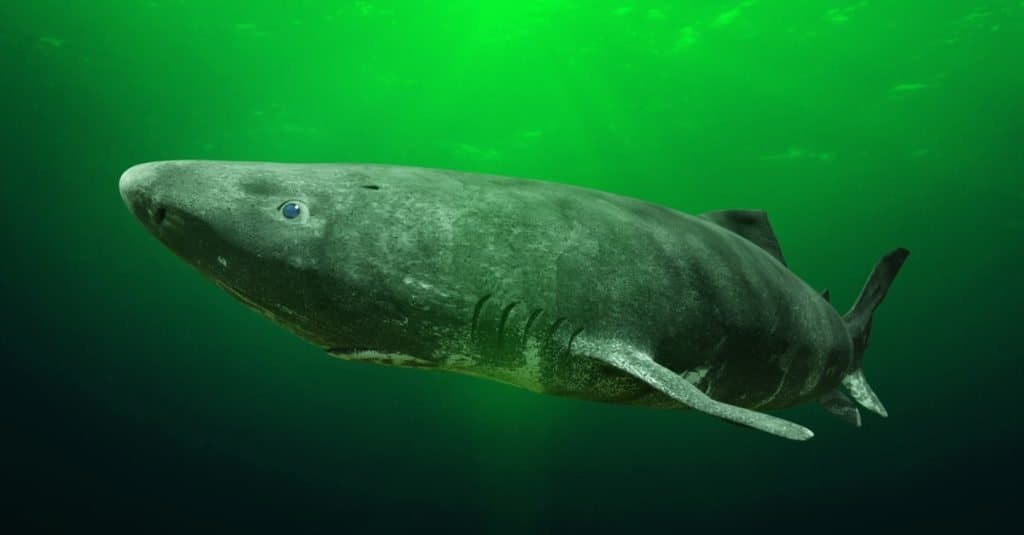
These
sharks are related to southern and Pacific sleeper
sharks. Like sleeper sharks, they live in very deep, cold parts of the
ocean
.
©Dotted Yeti/Shutterstock.com
Greenland sharks grow up to 21 feet long, and can live up to 500 years! Greenland sharks are designed to survive in very cold, deep waters; they’re found only in the northern Atlantic Ocean. Despite their huge size, they are not dangerous to humans.
9. Great Hammerhead
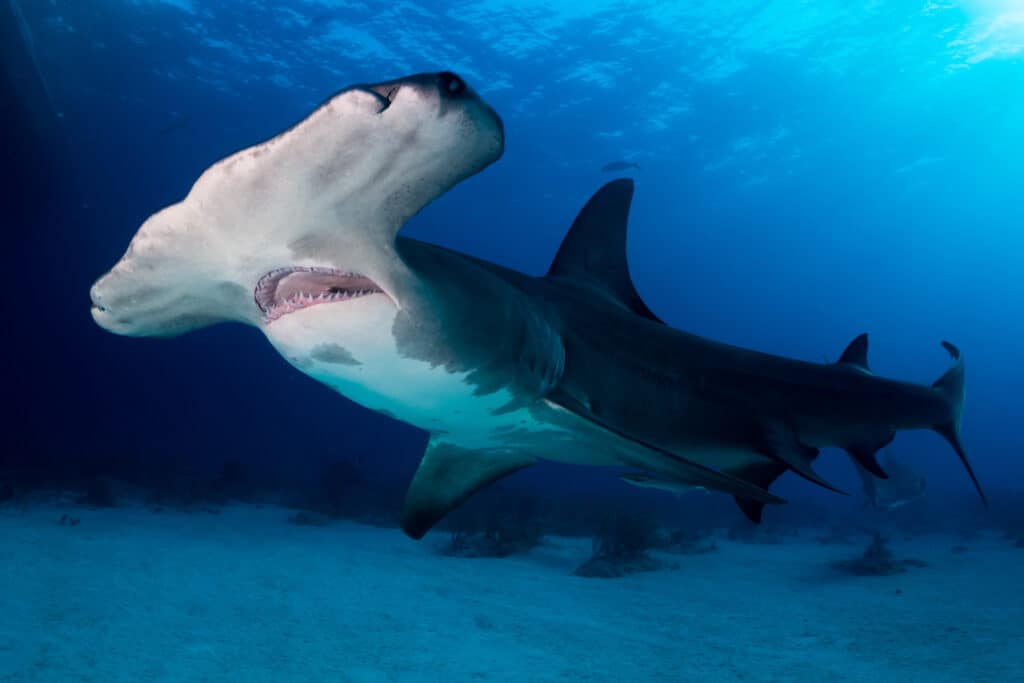
There are nine species of hammerhead, and many of them are in danger of
extinction
. Great hammerheads are
Critically Endangered
.
©HakBak/Shutterstock.com
One of the strangest living sharks in the sea is also one of the sharks that can grow bigger than great white sharks. Great hammerheads grow up to 20 feet long, and live only in shallow coastal waters. Their uniquely shaped heads are known as cephalofoils, and give them 360-degree fields of vision. These sharks eat bony fish, other sharks, squid, octopus, and even crustaceans.
8. Megamouth Shark
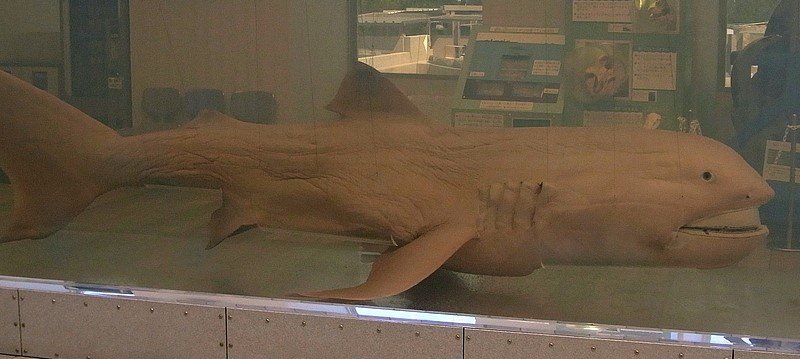
One of the weirdest animals of the sea, the
Megamouth Shark
, gets its name from its tub-like mouth.
©Open Cage / CC BY-SA 2.5, – License
Megamouth sharks are rarely seen, but, they’re some of the largest sharks in our oceans. Like basking sharks and whale sharks, megamouths filter feed, eating only the tiniest of creatures in the ocean, plankton. The most distinctive feature of the megamouth is, unsurprisingly, its very large mouth. Megamouths grow up to 18 feet long, though they present no threat to humans. These sharks spend their days on the ocean floor, coming closer to the surface to feed only at night.
7. Pacific Sleeper Shark
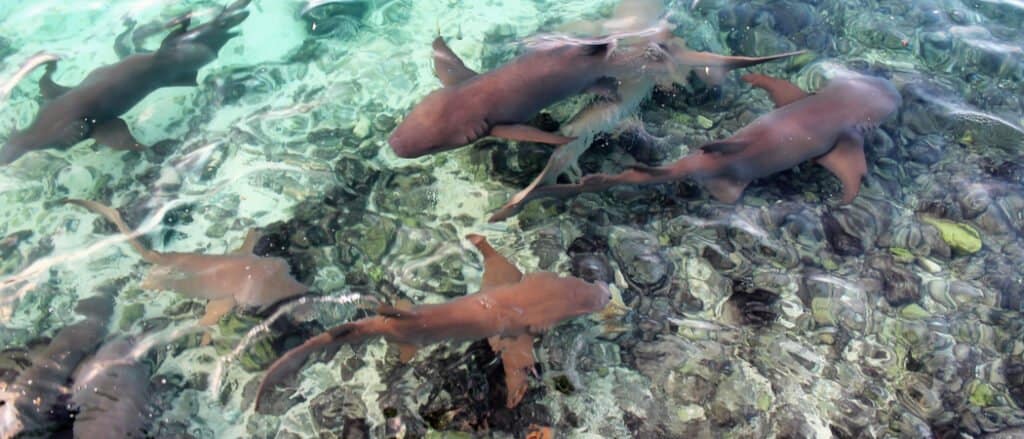
Known for their small, flattened dorsal fins, these sharks don’t look much like more typical sharks, like
tiger sharks
or bull sharks.
©shweta.onlinetester/Shutterstock.com
The largest Pacific sleeper sharks bigger than great white sharks are estimated to grow up to 23 feet long. Even so, the largest verified Pacific sleeper shark reached 1,958 pounds (nearly a ton), which is a size larger than all but the largest great white sharks.
Unlike most species of shark, Pacific sleeper sharks have two different kinds of teeth. Their top teeth are narrow and sharp, and their bottom teeth are flattened and serrated. They’re opportunistic feeders who eat just about everything that crosses their path, even carrion.
6. Thresher Shark
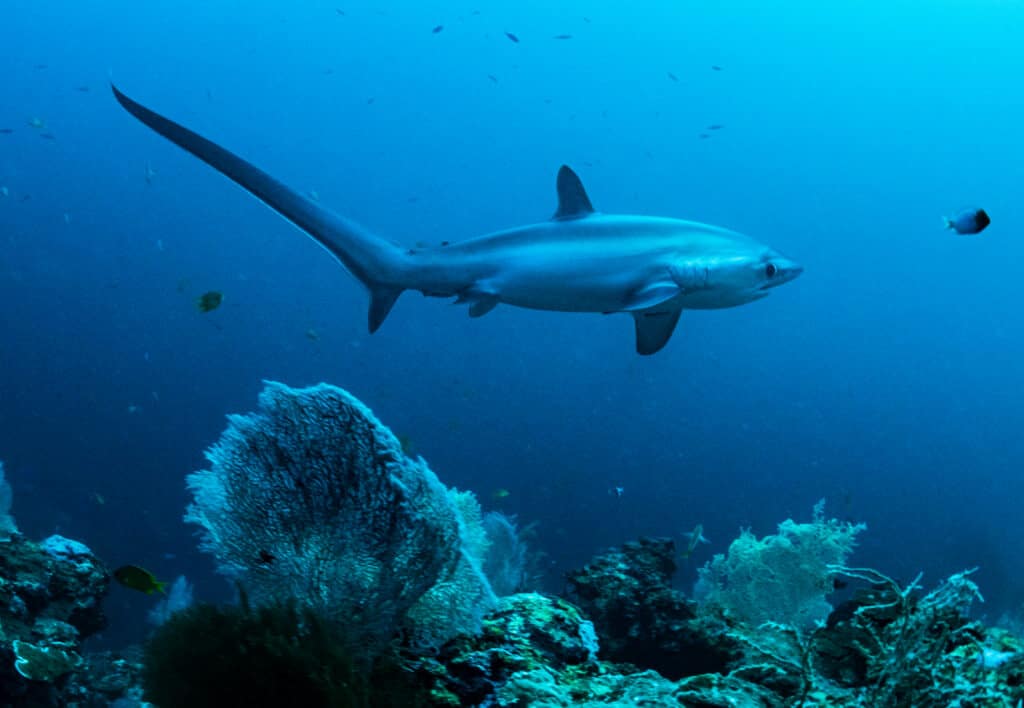
Known for their extremely long tails,
thresher sharks
are among the largest predatory sharks in the ocean.
©Shane Gross/Shutterstock.com
Thresher sharks bigger than great white sharks are not unheard of, in fact, they may be common. These sharks grow up to 24 feet long, with up to half their total length coming from their distinctive tail. Threshers actually use their tails to hunt by swimming into schools of fish and thrashing their tail to stun them. Currently, they’re listed as Vulnerable and have never been implicated in any attack on a human. Unfortunately, they’re frequent targets for fishermen who hunt them for their fins, the primary ingredient in shark fin soup.
5. Ginsu Shark
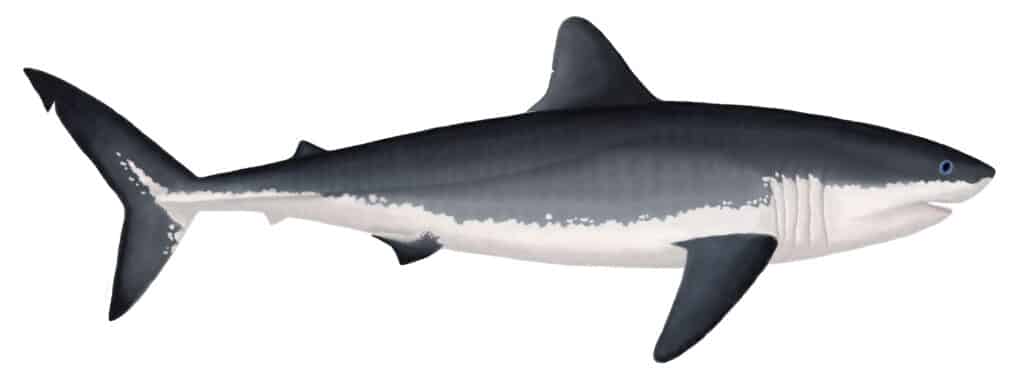
Known scientifically as
Cretoxyrhina mantelli, Ginsu sharks are named for the famously sharp Ginsu knife.
©CC BY-SA 4.0 – License
Ginsu sharks roamed ancient oceans between 107-73 million years ago. So, they’re actually a precursor to the massive Megalodon. They’re believed to have reached nearly 30 feet long, and likely preyed on massive animals like mosasaurs and large fish. Ginsu shark size can be estimated from the size of their teeth, which are three inches long. For comparison, great white teeth are only two inches long.
4. Otodus Shark
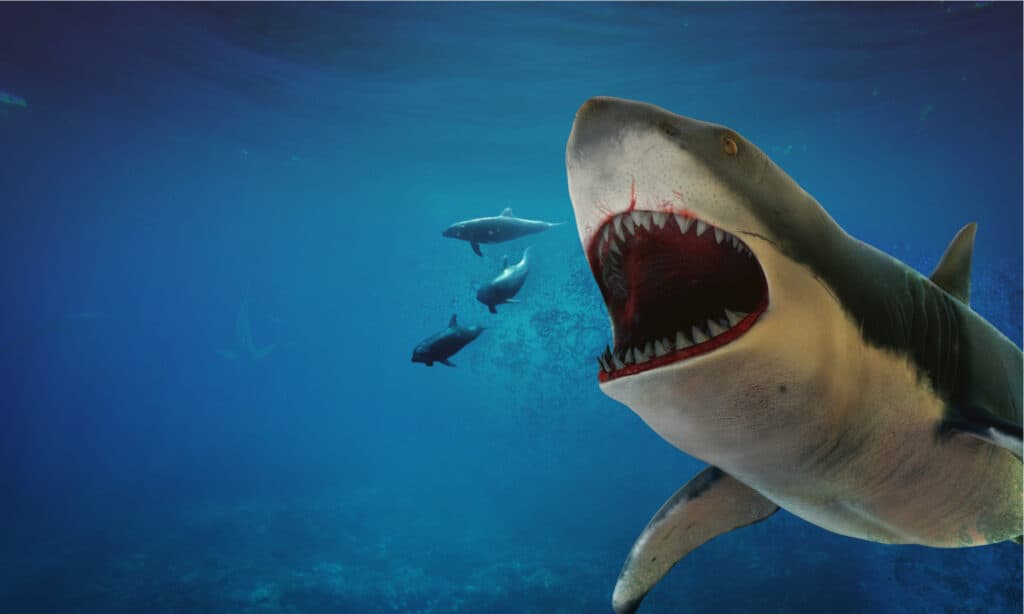
Similar to both the megalodon and today’s great white sharks, Otodus was a mackerel shark.
Salmon sharks
and porbeagles, though small, are also mackerel sharks.
©Antonio Viesa/Shutterstock.com
If it lived today, this shark bigger than great white sharks would dwarf the largest of great whites. Otodus, as the genus of sharks is known, is estimated to have grown up to 40 feet long or longer. These macro predators would have snacked on large bony fish, and potentially even other sharks. Their teeth are about five inches long, compared with great white teeth, which are a mere two inches long.
3. Basking Shark
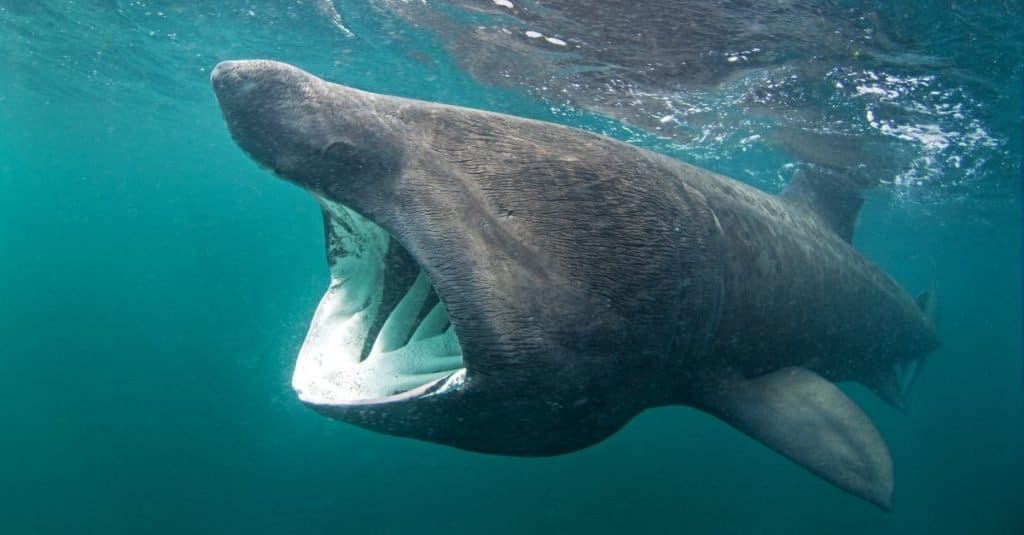
One of the strangest looking sharks, basking sharks are the second largest extant (living) sharks in the world.
©Martin Prochazkacz/Shutterstock.com
Basking sharks grow beyond 26 feet long, that’s the length of a school bus! These giants are anything but maneaters though, they eat plankton, the smallest critters in the ocean. They’re currently listed as Endangered, with their primary threats being pollution and overfishing. Basking sharks live in temperate and Arctic waters all over the world.
2. Whale Shark
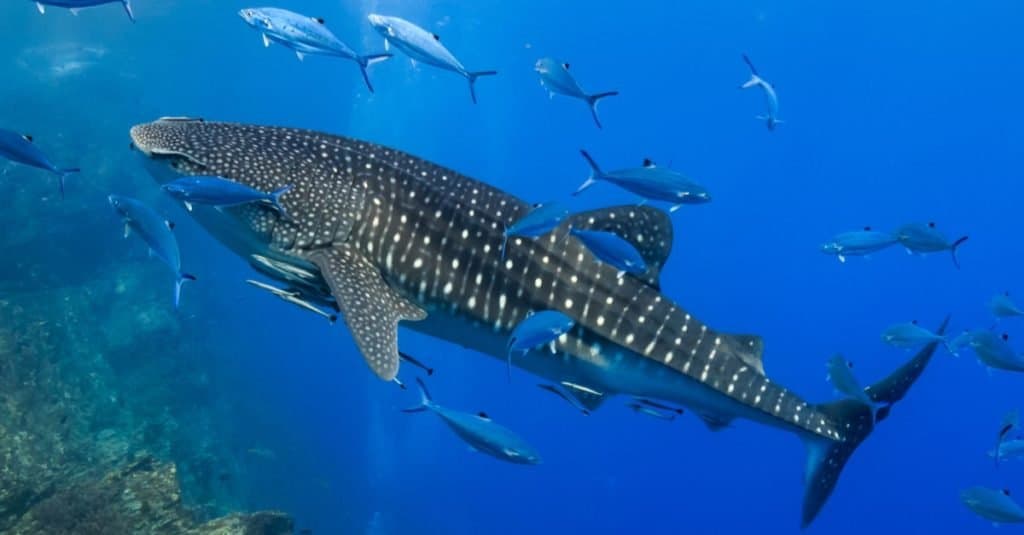
, the
whale shark
, is one of the most iconic sharks on the planet. Unfortunately, because of overfishing and pollution, they’re also classified as Endangered.
©Richard Whitcombe/Shutterstock.com
The largest extant sharks on Earth are whale sharks. These gentle giants can exceed 60 feet, which makes them about three times the size of even the largest great white sharks. A 60-foot shark might seem like a scary animal, but don’t worry—they pose absolutely no threat to humans. In fact, whale shark tourism is an increasingly popular form of ecotourism. These sharks live in tropical waters all over the world, where they feed on plankton. Like baleen whales, whale sharks are filter feeders. Whale sharks have very large tails and pectoral fins. They’re also spotted and have very large mouths.
1. Megalodon Shark
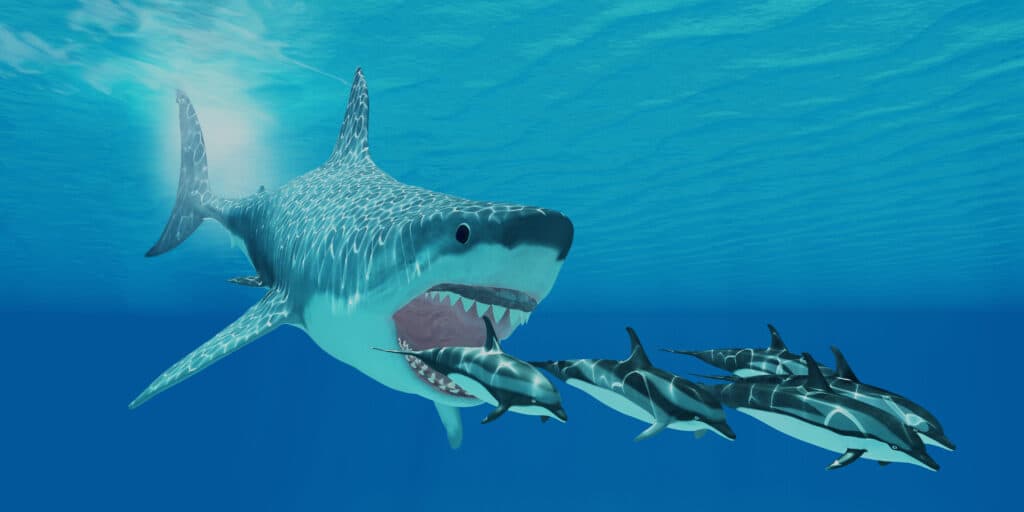
These sharks were so big that their teeth are the size of a human hand; their name literally means ‘big tooth’.
©Catmando/Shutterstock.com
The largest shark that ever lived is the megalodon. These sharks bigger than great white sharks grew up to 60 feet long and easily could have eaten even the largest of today’s sharks. Megalodon lived from 23 million years ago up until around 2.6 million years ago. They’re thought to have looked like giant versions of today’s great white sharks.
Top Five Largest Animals
The animal kingdom is full of a diverse range of creatures, from the tiniest insects to the largest mammals on the planet. We covered the largest sharks in the world that are bigger than the great white, but what other mammals are considered to be the largest and in charge?
Let’s dig in, here are five of the largest animals:
- Blue Whale: The blue whale is the largest animal in the world and can reach up to 100 feet in length and weigh around 200 tons.
- African Elephant: The African elephant is the largest land animal, and the males can weigh up to 14,000 pounds and reach a height of 10 to 13 feet at the shoulder. T
- Saltwater Crocodile: The saltwater crocodile is the largest living reptile and can grow up to 23 feet in length and weigh up to 2,200 pounds.
- Giraffe: The giraffe is the tallest land animal and can reach up to 18 feet in height.
- Whale Shark: The whale shark is the largest fish in the world and can grow up to 40 feet in length and weigh up to 20,000 pounds.
Summary of the 10 Sharks Bigger than Great White Sharks
| Name of Shark | Length in Feet | Habitat | Conservation Status |
|---|---|---|---|
| Megalodon | 60 | Coastal areas of all but polar oceans | Extinct |
| Whale | 60+ | Tropical waters | Endangered |
| Basking | 26+ | Temperate and Arctic waters | Endangered |
| Otodus | 40 | Warm and temperate waters | Extinct |
| Ginsu | 30 | Subtropical regions | Extinct |
| Thresher | Up to 24 | Temperate and tropical oceans | Vulnerable |
| Pacific Sleeper | 23 | Pacific Ocean from Japan to Mexico on continental shelves and slopes | Near Threatened |
| Megamouth | 18 | Floor of the Indian, Pacific, and Atlantic Oceans | Least Concern |
| Great Hammerhead | 20 | Shallow coastal waters | Critically Endangered |
| Greenland | 21 | Very cold, deep waters of the North Atlantic | Vulnerable |
The photo featured at the top of this post is © Digital Storm/Shutterstock.com
Thank you for reading! Have some feedback for us? Contact the AZ Animals editorial team.





